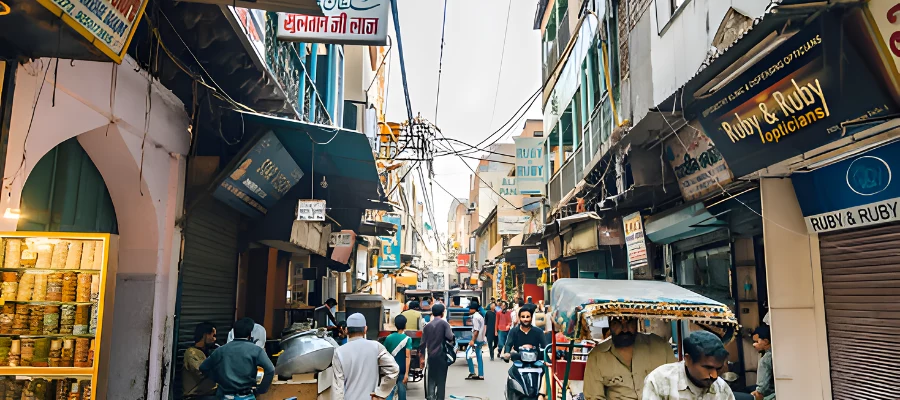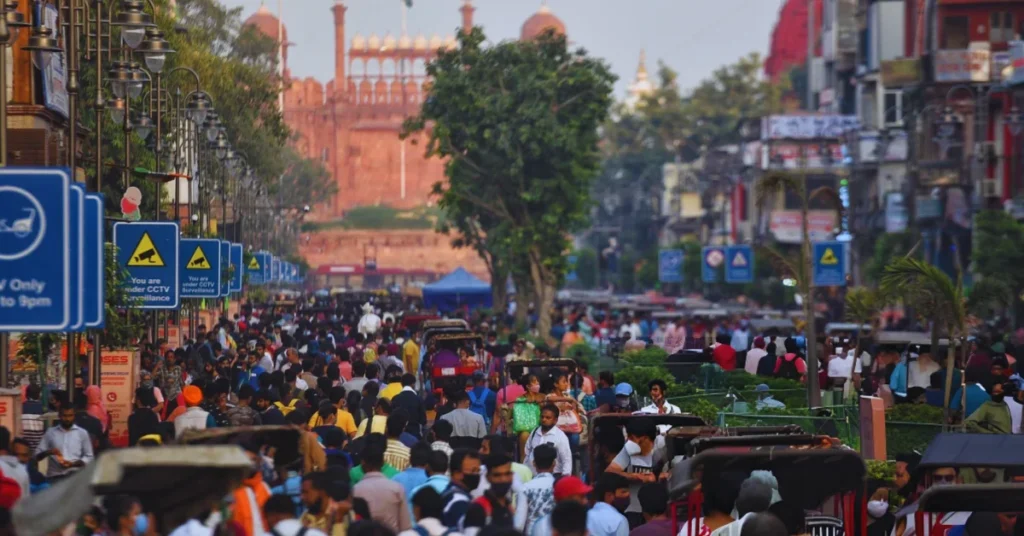I have walked through Chandni Chowk many times, but every visit still surprises me. The noise, the smell of spices, the crowd of people—it feels like a movie that never ends. But what many visitors don’t see are the quiet corners and secret stories hidden behind those busy streets.
If you move away from the main road and step into the small lanes, Chandni Chowk becomes a different world. There are peaceful courtyards, old houses with carved doors, tiny temples, and food stalls that don’t appear on any tourist list. Let’s explore this hidden side of Chandni Chowk Delhi together.
What is Chandni Chowk Delhi famous for?
Chandni Chowk is one of the oldest and busiest markets in Delhi. It was built in the 17th century by Mughal Emperor Shah Jahan and designed by his daughter Jahanara Begum. It is famous for its colorful shops, ancient temples, mosques, and delicious food.
You can find everything here—bridal wear, spices, jewelry, silver, books, and sweets. But the real beauty of Chandni Chowk is not only in what you can buy, it’s in how the place feels. The narrow streets tell stories from hundreds of years ago.
Yet, behind the chaos, there are places most people miss. That’s where the real magic lies.
Hidden Gems and Secret Alleys in Chandni Chowk
1. The Quiet Haveli Lane
Just a few turns away from the main market road, you’ll find narrow alleys lined with old havelis (traditional mansions). Some still have the original wooden doors, colored glass windows, and hand-painted walls. If you walk slowly, you can hear echoes of the past — merchants talking, families celebrating, children playing in the courtyards.
Most visitors never enter these lanes. Locals, however, will gladly tell you small stories about who lived there and what happened many years ago.
2. The Small Jain Temples
Apart from the big Jain Lal Mandir near the Red Fort, there are tiny Jain temples hidden inside the residential lanes. They are peaceful, clean, and decorated with mirrors and marble. You can sit for a while and listen to the sound of bells. It’s the calmest part of the whole area — a real break from the crowd outside.
3. The Rooftop View
If you ask a local shopkeeper politely, they might allow you to go up to a rooftop. From there, Chandni Chowk looks completely different. You’ll see domes, flags, wires crossing the sky, and the faint sound of azan or temple bells in the background. In the evening, when the sun sets behind the Red Fort, this view feels like a hidden secret of the city.
4. The Old Book Lane
Behind Nai Sarak, there’s a narrow street filled with old bookshops. Some have been running for generations. The smell of paper and ink fills the air. If you are lucky, you might find someone selling rare Urdu or Hindi books, or even handwritten notebooks used by students from decades ago.
Street Food Away from the Crowd
Everyone talks about Paranthe Wali Gali, but that’s not the only place to eat. There are smaller stalls that locals love but tourists never notice.
- A small shop sells aloo tikki and chhole near the spice market. The owner has been cooking the same recipe for forty years.
- You’ll find sweet lassi in clay cups in the bylanes of Kucha Mahajani.
- A tiny tea stall tucked inside a corner serves masala chai so strong it could wake anyone from a nap.
If you follow your nose and not the guidebook, you’ll find food that tells its own story.
Less-Visited Temples, Havelis, and Markets
- Small Temples: Scattered across Chandni Chowk are temples dedicated to Hanuman, Krishna, and Durga. Some are hidden behind cloth shops or inside courtyards.
- Havelis of Old Traders: These grand old homes are slowly fading, but some still show the charm of Mughal and British architecture. You can see beautiful arches, long balconies, and thick wooden doors.
- Quiet Markets: Most people crowd the main road, but if you turn into side alleys like Katra Neel or Kinari Bazaar, you’ll see smaller workshops. Craftsmen here make zari work, silver jewelry, and handmade perfumes.
These are not modern shopping complexes — they are working memories of Old Delhi.
Is Chandni Chowk Cheap or Expensive?
That depends on what you buy. Street food, books, and small souvenirs are very cheap. Fabric, jewelry, and wedding wear can be expensive. Always check prices in a few shops before buying anything. Bargaining is normal here, but be polite. Locals appreciate good manners more than loud voices.
On Which Day is Chandni Chowk Closed?
Most of Chandni Chowk stays open from Tuesday to Sunday. Many shops take a holiday on Monday. However, some food stalls and temples remain open all week. If you want to enjoy both shopping and food, plan your visit between Tuesday and Friday—it’s less crowded than weekends.
Which Day is Best to Visit Chandni Chowk Delhi?

If you love photography or peaceful walks, come early in the morning between 7 and 9 a.m. The market is slowly waking up, the air smells of fresh bread and incense, and you can take beautiful pictures without too many people around.
If you like lively energy, come around 5 to 7 p.m., when shops are glowing with yellow lights and food stalls are busiest.
Avoid visiting during big festivals like Diwali or Eid unless you are ready to handle huge crowds.
Tips for Exploring Chandni Chowk Delhi
- Dress comfortably: The lanes are narrow and full of people. Light clothes and shoes are best.
- Carry small cash: Many shops still prefer cash, not cards.
- Stay alert: Chandni Chowk is safe, but it’s easy to lose your way. Keep your phone charged and note a few landmarks.
- Ask locals: Delhi people love to help. If you ask politely, they’ll tell you where to eat or which lane to take.
- Stay hydrated: Walking here takes energy. Keep a bottle of water with you.
Suggested 1-Day Walking Plan
Here’s a simple one-day walking itinerary to experience both the famous and hidden sides of Chandni Chowk.
Morning (7:00 a.m. – 10:00 a.m.)
Start at the Red Fort gate. Visit the Jain Lal Mandir opposite it. Then walk toward the Gauri Shankar Temple and Gurudwara Sis Ganj Sahib. These three places of worship show the unity of faiths in one small area.
Late Morning (10:00 a.m. – 12:00 p.m.)
Explore the lanes of Dariba Kalan for silver jewelry, then head to Ballimaran to see old houses and poetry corners. Take your time and talk to local shopkeepers.
Lunch (12:00 p.m. – 1:00 p.m.)
Eat at a small dhaba or sweet shop. Try kachori, lassi, or paratha—not just the famous ones, but small vendors in side alleys.
Afternoon (1:00 p.m. – 3:00 p.m.)
Visit Khari Baoli, the spice market. The smell of cardamom, cloves, and cinnamon will fill the air. You can also buy some spices to take home.
Evening (3:00 p.m. – 6:00 p.m.)
Walk slowly back toward Chandni Chowk road. Climb up to a rooftop if possible. Watch the sun go down over the old domes. Have a cup of chai and some samosas.
By the time you leave, you’ll realize that the charm of Chandni Chowk is not just in the crowd—it’s in the quiet corners where time has stopped.
Travel Information
- Nearest Metro Station: Chandni Chowk (Yellow Line). You can also use Lal Qila or Chawri Bazar stations depending on where you start your walk.
- Timings: Most shops open around 10 a.m. and close by 8:30 p.m.
- Open Today?: If it’s not Monday, yes — almost everything will be open.
- Best Time of Year: October to March, when the weather is cool for walking.
A Few Local Secrets
- Always look up! The upper floors of the buildings have the best old carvings and balconies.
- Some families still live in 100-year-old houses. If they invite you for tea, say yes.
- The shop signs might look new, but many businesses are several generations old. Ask their stories—you’ll hear about Delhi’s real past.
Why You Should Visit the Hidden Side of Chandni Chowk
Chandni Chowk Delhi is not just a market; it’s a living museum. Behind every corner is a story. You might meet an old bookseller who knows Urdu poetry by heart or a cook who learned recipes from his grandfather.
Most tourists rush through, take pictures, and leave. But if you slow down and look closer, you’ll find beauty in the smallest details — a flickering lamp, a child laughing in a shop, a woman drawing rangoli on a doorstep.
This is the true Chandni Chowk — not just noise and shopping, but a place full of life and memories.
Conclusion
Chandni Chowk Delhi is more than a busy market — it’s a place full of hidden charm and old stories. Behind the noise and crowd, you’ll find quiet lanes, friendly locals, and timeless beauty. Walk slowly, explore freely, and you’ll see a side of Chandni Chowk that most visitors miss — simple, real, and full of life.
If you enjoyed this story, share it with friends who love exploring local culture. And when you visit Chandni Chowk next time, don’t just shop—walk slowly, look around, and find your own secret lane.
That’s how Delhi truly reveals itself.


